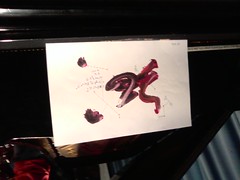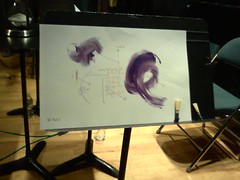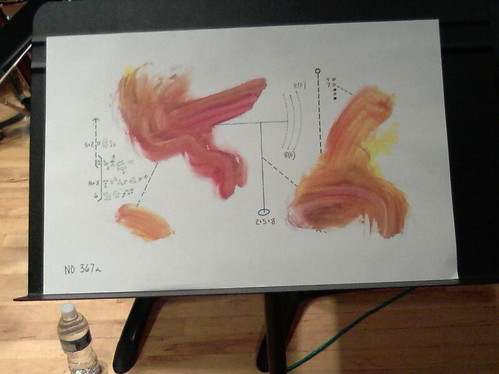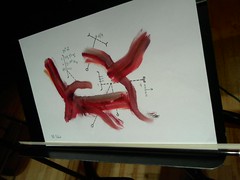Anthony Braxton’s score for saxophones & contrabass clarinet
I found myself in the curious – indeed, unprecedented – situation on Saturday evening of coming away from an Anthony Braxton concert feeling disappointed. Was it the room? The chapel of St. Mark’s church in
Was it the music or the musicians? Braxton himself was not playing, but conducting, and the two pieces entailed nothing but brass – No. 103 for seven trumpets & No. 169 for brass quintet (two trumpets, French horn, trombone & tuba). The former in particular made me realize just how little trumpet goes a long way, unless perhaps Miles Davis is handling it. Even with the great Taylor Ho Bynum in the mix, it didn’t feel as tho Braxton was fully exploiting the possibilities of the instrument, and tho there were some tremendous moments – including one solo that didn’t sound like a trumpet so much as a landing jumbo jet – my sense when it concluded was “wait, wait, there’s so much more to be done.” Costumes made especially for this piece by Rosemary Kielnecker – green pullover court-jester shirts, black capes, “Zorro” masks (3 of which had to be worn under glasses to unintended comic effect) & caps – did not contribute to the musicianship & frankly paled as theatrics in the context of the heavy handed architecture of the room.
The second piece was truncated – lasting roughly half the length of the hour described in the program (and without the use of swivel chairs specified in the original composition). It was, however, only the second time Braxton has been able to mount this work with the intended instrumentation (there is a version for four saxophones around, recorded in Slovenia in 2000, that I would love to hear), and the presence of Jay Rozen on tuba was a delight all its own, playing the instrument like a percussionist, dropping pie plates into the bell, hitting notes you feel deep in your spine. In part, I’m sure that the abbreviation of the piece was done in order to get through it before the great tower bell of the church tolled ten – Jack Krick & I noted what an impact the bell would have had an hour earlier had it not rung during the intermission.
Ultimately, tho, I think the primary problem with the event on Saturday was the contrast from the night before, when I heard Braxton performing with his Falling River Quartet in what might have been the best single concert I’ve ever heard him give. The location was a relatively small performance space in the
Seeing Braxton emerge on stage, a 63-year-old African American music legend, looking positively avuncular with his signature cardigan sweater & John Lennon glasses, followed by three young white women, none of whom appears yet to be 30, brought up every memory I had of watching Chuck Berry & Bo Diddley performing with local backup bands. I recall one band at some no-name club at Fillmore & California in San Francisco in the late seventies looking positively embarrassed at having to perform what amounted to the same beat over & over with nary a chord change from one Bo Diddley ditty to the next. Even backed by Johnny Otis’ excellent band, Chuck Berry used other musicians as pure backdrop – he might as well have had a tape. The concert at the
For one thing, Braxton did not play the star. If you closed your eyes, you heard an exquisitely balanced quartet, every one of them startlingly good instrumentalists. The piece they played – which I hope they release on CD – was a composite of four differently numbered charts using the highly graphic scoring system Braxton has evolved over the years (by contrast, the score for the 1983 composition No. 103 the following night was essentially conventional in its notation). Cumulatively, the piece had some moments of astonishing lyricism, reminiscent of Steve Lacy’s work with Michael Smith, and situated itself almost perfectly on the midpoint between free jazz & contemporary “classical” music. I’ve never heard a piece that was so perfectly both without lapsing into an either/or. Possibly this has to do with Braxton – he’s long been an advocate for a music that did not worry about categorical constraints (and has sometimes been dinged for this by jazz purists, tho I once saw him perform an evening of duets with Sam Rivers at the late lamented Keystone Korner in San Francisco’s North Beach where he held his own with the old school sax man just fine, thank you). And it may just be that the current generation of younger musicians have simply gotten beyond this. Katherine Young’s website notes her work with rock bands, not something many bassoonists are wont to do. But Katherine Young’s bassoon was as spectacular as Jay Rozen’s tuba a night later – she’s one musician I’d happily go to hear an evening of solo performances by. So it might not be “the current generation” so much as these musicians here. Dave Brubeck never had a group that performed so in synch with one another. So while there were moments when I would watch Braxton himself play – you really notice what huge hands he has when they’re grappling one of the smaller saxes – this was not an evening about a great performer but rather a great ensemble. And it was one of those evenings that reminds you just why music is both wondrous and important.
Ars Nova Workshop, which is bringing the


L-R: Scores used by Sally Norris (piano), Katherine Young (bassoons), Erica Dicker (violins)







